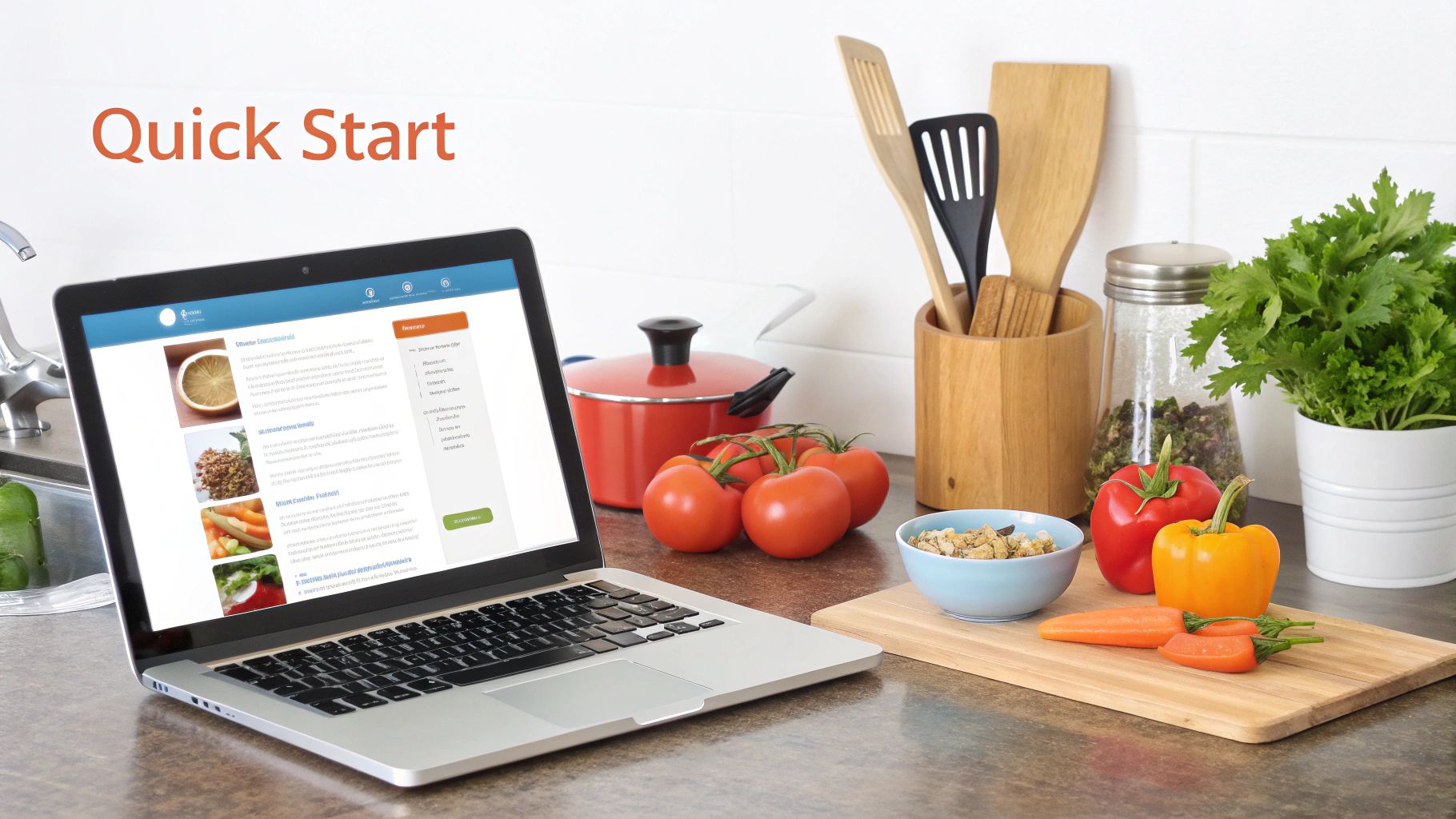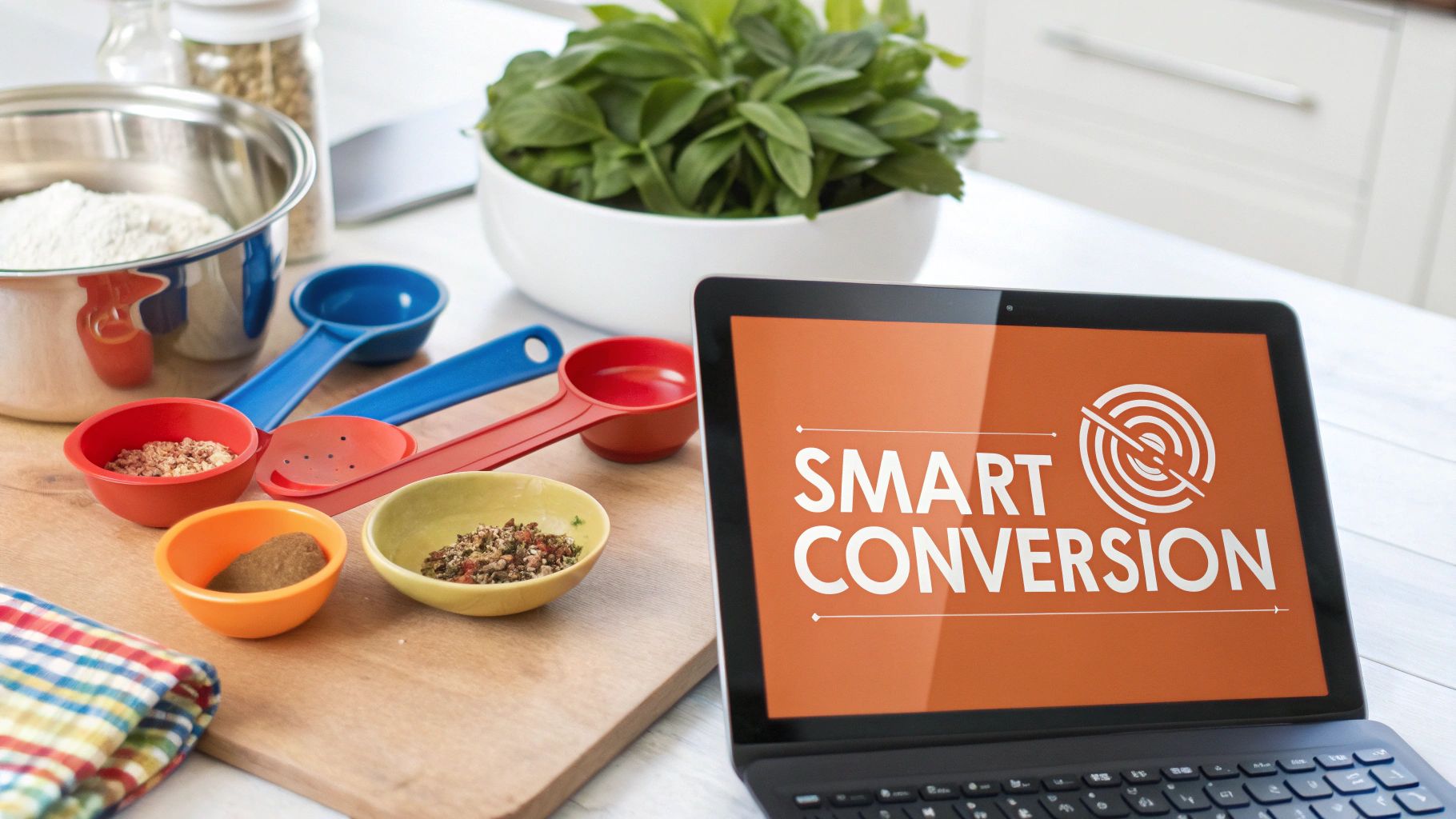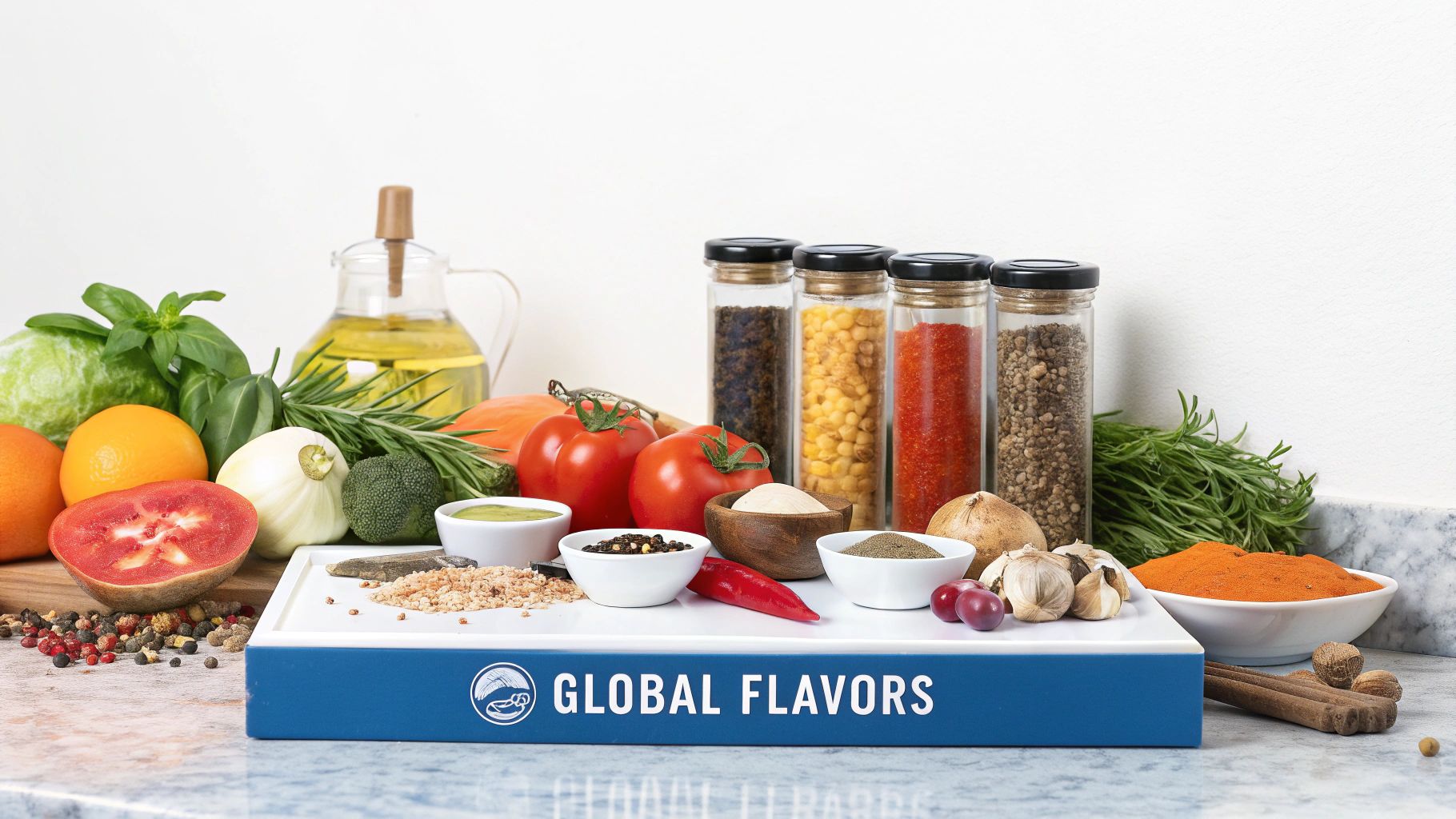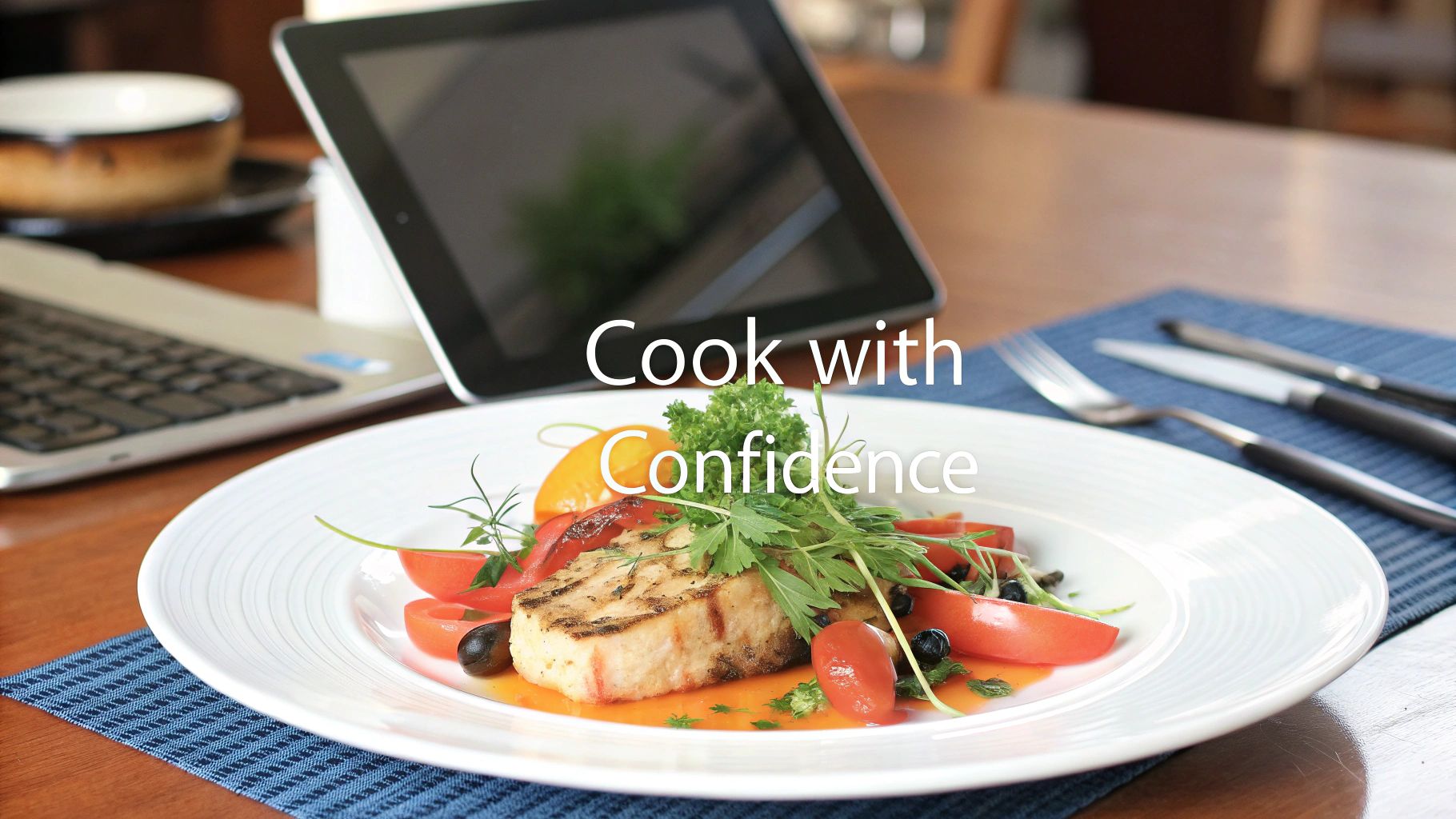Why Every Home Cook Needs a Recipe Converter

We've all been there. You find a delicious recipe, but it serves six, and you only need two. Or maybe the recipe uses metric measurements, and you're more comfortable with cups and ounces. A recipe converter is a simple solution to these common cooking challenges. It can smoothly transform a potential kitchen disaster into a successful cooking experience.
Imagine halving a complicated lasagna recipe with many ingredients. Doing the math for each ingredient can be tedious and prone to errors. A recipe converter eliminates this mental gymnastics, allowing you to adjust ingredient quantities confidently. Plus, it helps reduce food waste by letting you cook precisely what you need.
Recipe converters allow you to use any recipe, no matter the original serving size or measurement system. They are especially helpful for adapting treasured family recipes or using international cookbooks. This ease of use contributes to the rising popularity of these digital tools. The global recipe apps market, which includes recipe converters, is expected to grow from $5.80 billion in 2024 to $6.41 billion in 2025. This reflects a growing interest in digital meal planning tools. Learn more about recipe app market growth here.
Benefits of Using a Recipe Converter
These tools offer several advantages beyond just scaling recipes:
- Precise Adjustments: Accurately convert recipes and prevent cooking mistakes due to incorrect scaling.
- Reduced Food Waste: Cook the exact amount needed, minimizing leftovers and saving money.
- International Cooking: Easily adapt recipes from other countries by converting unfamiliar units into your preferred system.
- Dietary Adaptations: Adjust recipes to meet dietary restrictions, like reducing sugar or increasing protein.
- Time Savings: Skip manual calculations and enjoy more time cooking.
From Family Favorites to Global Cuisine
A recipe converter is a valuable tool in several situations. Perhaps you have a beloved family recipe written on a faded card, meant to feed a large group. A converter helps you easily scale it down for a smaller gathering. Or maybe you find an enticing Thai curry recipe online, but the measurements are metric. A converter effortlessly translates those grams and milliliters into cups and ounces.
This flexibility encourages culinary exploration and makes cooking more enjoyable by removing the frustration of complex conversions. A recipe converter is a must-have for every modern home cook, simplifying meal preparation and boosting culinary creativity.
AI Revolution: How Smart Recipe Converters Actually Work

Recipe converters have come a long way. They’ve evolved from simple multiplication tools to sophisticated programs that understand the nuances of cooking. This is thanks to the integration of artificial intelligence (AI) and machine learning (ML).
These technologies allow converters to understand the complex relationships between ingredients, resulting in more accurate conversions. This represents a major step forward in how we adapt recipes to our needs. A growing trend is the use of AI and ML for personalized recipe recommendations based on individual dietary needs and preferences. You can find more statistics on the recipe apps market.
Understanding Ingredient Relationships
Consider converting a cake recipe that uses baking powder. Simply multiplying the amount of baking powder might not work. AI-powered converters grasp the role of baking powder in a cake's texture and rise.
They adjust the amount not just based on the recipe size but also on how that change will affect the final product. This deeper understanding creates a more reliable conversion, maintaining the recipe’s intended outcome.
Learning From Thousands of Recipes
These intelligent systems learn from a vast database of successful recipe adaptations. By studying how scaling impacts flavor, texture, and cooking times in thousands of recipes, these converters can predict the best adjustments for your specific needs.
This goes beyond basic math, offering genuinely intelligent suggestions. For a deeper dive into recipe conversion, check out this article on how to master recipe conversion.
Personalized Kitchen Companions
Some recipe converters are becoming personalized kitchen assistants. They can store your preferences, like your preferred measurement system (metric or imperial) and dietary restrictions (vegan, gluten-free).
Some even consider regional ingredient variations, further improving accuracy. This personalization offers amazing precision and flexibility in recipe modification.
The Evolution of Recipe Converters
The following table, "Evolution of Recipe Converter Features," shows the progress of recipe converters, from basic functions to advanced AI capabilities. It highlights the key features, technology used, and benefits for users in each era.
| Era | Primary Features | Technology Used | User Benefits |
|---|---|---|---|
| Early Converters | Basic multiplication/division | Calculators | Simple scaling, potential for inaccuracies |
| Advanced Converters | Unit conversion, ingredient substitution | Databases | Increased accuracy, broader application |
| AI-Powered Converters | Personalized recommendations, nuanced scaling | AI/ML | Preserved recipe integrity, dietary adaptation, personalized experience |
This table demonstrates how recipe converters have become increasingly sophisticated, providing greater accuracy and personalization. The introduction of AI and ML has dramatically enhanced their capabilities, offering benefits far beyond simple scaling.
These advances make cooking more accessible and enjoyable, giving home cooks the confidence to try any recipe. This is a major shift in home cooking, where technology and culinary arts combine for a more efficient and satisfying cooking experience.
Top Recipe Converters That Actually Deliver Results
Finding the right recipe converter can feel like a daunting task with the sheer number of options available. This section explores tools that genuinely improve your cooking experience. We'll evaluate both free and premium converters across various platforms, focusing on accuracy and ease of use. We'll also examine specific conversion capabilities, from basic scaling to international unit conversions, ingredient substitutions, and integration with recipe websites.
Key Features to Look For
Whether you’re a casual home cook or a seasoned chef, certain features are essential in a good recipe converter:
- Accurate Scaling: The most important function is precise scaling for different serving sizes.
- Unit Conversion: Seamless conversion between metric and imperial units (grams to ounces, milliliters to cups) is a must.
- Ingredient Substitution: Offering suggestions for alternative ingredients based on dietary restrictions or availability is a helpful addition.
- User-Friendly Interface: An intuitive design is crucial for a smooth and enjoyable experience.
- Platform Compatibility: Availability across web, mobile, or as browser extensions adds convenience.
Recommended Recipe Converters
This table summarizes some top-performing converters:
| Converter Name | Platform | Key Features | Best For |
|---|---|---|---|
| Example Converter 1 | Web, iOS, Android | Accurate scaling, unit conversion, nutrition info | Health-conscious cooks |
| Example Converter 2 | Web | Ingredient substitution, recipe import | Baking enthusiasts |
| Example Converter 3 | Browser Extension | Quick conversions, metric/imperial units | On-the-go cooks |
This isn't an exhaustive list, but it's a great starting point for your search. Remember to choose a converter that aligns with your individual needs and cooking style.
Beyond Basic Conversion
Many converters go beyond simple unit and serving size adjustments. Some integrate with popular recipe websites, enabling direct recipe import for conversion. Others offer advanced features such as nutritional tracking. This adds significant value, making these converters indispensable kitchen tools. You might be interested in: How to choose the best recipe management app.
Finding the Right Fit
While each converter has its strengths, consider your own requirements. If you bake frequently, a converter with precise ingredient scaling is essential. If healthy eating is your focus, a converter with nutritional data integration might be a better choice.

The right recipe converter empowers you to adapt recipes confidently. It should fit seamlessly into your cooking routine and help you create delicious meals every time. With so many options, finding the perfect converter for your needs is entirely possible. Explore the available converters and see how they can elevate your cooking.
Helpful Resources for Students
For students looking to improve their studies, there are many helpful resources available. Check out this article on AI tools for more information.
Beyond Measurements: Nutrition Tracking Revolution

Recipe converters are evolving. They're no longer just for adjusting measurements. Now, they're becoming key tools for managing nutrition. Leading recipe converters connect to large nutrition databases. This gives you detailed macro and micronutrient information that updates instantly as you tweak your recipes.
This integration is changing how people plan meals. Health-conscious cooks, athletes, and people managing medical conditions are all benefiting. When choosing a recipe converter, nutrition tracking is a must-have feature. For example, consider how ingredient integration works by analyzing data from Japanese Skincare Brand Kosé.
Maintaining Accuracy in Complex Modifications
Scaling a recipe for a crowd while accommodating dietary needs can be tricky. These tools help maintain nutritional accuracy, even with complex changes. Substituting an ingredient? The converter updates the nutritional information automatically.
This feature bridges the gap between enjoying cooking and sticking to dietary restrictions. It takes the guesswork out of healthy cooking. No more laborious manual calculations!
Some advanced recipe converters even offer smart suggestions. They recommend substitutions that not only meet your dietary goals, but also maintain the recipe’s flavor profile. This makes healthy cooking more accessible and enjoyable.
The Power of Nutritional Databases
Accurate nutrition information relies on robust databases. FatSecret's Platform API, for instance, is a massive nutrition database. It boasts over 1.9 million verified food items and 17,000 international recipes.
Supporting over 35,000 developers, the FatSecret API helps create apps with detailed nutrition analysis and diet planning features. This extensive data ensures reliable nutritional breakdowns within recipe converters.
To understand the impact of comprehensive nutrition databases, let’s look at a comparison of some leading recipe converters. The table below details their nutrition capabilities.
Nutrition Data Comparison in Leading Recipe Converters
| Recipe Converter Tool | Nutrition Database Size | Dietary Restriction Filters | Accuracy Rating | Special Features |
|---|---|---|---|---|
| Converter A | 500,000+ | Gluten-Free, Vegan, Vegetarian, Keto | 4/5 | Recipe suggestions based on dietary needs |
| Converter B | 1,000,000+ | Gluten-Free, Vegan, Vegetarian, Paleo, Keto | 4.5/5 | Calorie tracking, macro tracking |
| Converter C | 250,000+ | Gluten-Free, Vegan, Vegetarian | 3.5/5 | Basic nutrition information |
This table shows the variety in nutrition features. While most converters offer basic filtering, the size of the database and special features can significantly impact the user experience. Consider your specific needs when choosing a converter.
Real-World Applications
The benefits of nutrition tracking in recipe converters are wide-ranging. For athletes, tracking protein and carbohydrate intake is essential. For people with diabetes, managing sugar is vital.
Recipe converters with integrated nutritional data empower these groups. They can maintain their health while still enjoying food. These tools simplify meal planning for specific dietary needs. They are becoming essential for a healthy lifestyle.
Solving the Trickiest Recipe Conversion Challenges
Even the best recipe converters can't handle every culinary curveball automatically. However, with a little know-how, you can overcome these challenges. This section addresses the most common recipe conversion problems that can stump even seasoned cooks.
Scaling Ingredients: Not Always a Straight Line
Some ingredients don't scale proportionally. For example, consider leavening agents like baking powder and yeast. Doubling a recipe doesn't necessarily mean doubling the baking powder. Too much, and your cake might explode in the oven; too little, and it will be dense and flat.
Salt and spices also require careful adjustment. Their intensity can become overpowering or underwhelming if scaled incorrectly. Learn more in our article about How to master recipe conversion.
For example, when halving a recipe, you might reduce the salt by slightly more than half to maintain the intended flavor balance. This is where understanding the role of each ingredient becomes vital. You might also be interested in: How to choose the best recipe management app.
Volume vs. Weight: Precision in Baking
Converting between volume (cups, tablespoons) and weight (grams, ounces) is especially critical in baking. Volume measurements can be inconsistent due to variations in ingredient density.
For instance, a cup of loosely packed flour weighs less than a cup of tightly packed flour. This difference can significantly affect your baked goods. Using a kitchen scale and converting to weight measurements offers greater precision and consistency.
Think of it like building a house: precise measurements ensure a stable structure, just as precise ingredient weights ensure a successful bake. This precision becomes even more important with sensitive ingredients like yeast and baking powder. Even a small variance can have a big impact.
International Conversions: Decoding Global Cuisines
International recipes introduce exciting new flavors, but they can also bring measurement confusion. Different countries have varying standards for flour, sugar, and other staple ingredients.
For example, all-purpose flour in the US has a different protein content than all-purpose flour in Europe. Similarly, the term “sugar” can refer to granulated sugar, caster sugar, or even powdered sugar depending on the region.
Furthermore, ingredient names can vary across languages. This can make it difficult to identify equivalent ingredients. Understanding these regional variations is crucial for successful international recipe conversions.
Regional Flour Differences: Impact on Texture
Flour, a baking staple, presents a unique challenge in international recipe conversions. Different countries classify and mill their flour differently, affecting protein content and therefore, gluten development.
This means that using an American all-purpose flour in a French bread recipe might not yield the desired chewy texture. Researching regional flour equivalents and making appropriate substitutions will ensure your international baking adventures are a success.
Sugar Varieties: Sweetness Beyond Granules
Sugar isn't just sugar. From granulated to caster to powdered, the variety can be dazzling, and these variations matter in baking. Granulated sugar provides structure and sweetness, while caster sugar dissolves quickly and is ideal for meringues.
Powdered sugar, with its fine texture, is perfect for frostings. Using the correct sugar type, as specified in the original recipe, ensures the proper texture and sweetness in your final product.
Overcoming Ingredient Terminology Variations
Navigating ingredient terminology across different languages can be a minefield for any cook. One country's "courgette" is another's "zucchini." A "swede" in the UK is a "rutabaga" in the US.
These variations can make following international recipes confusing. Online dictionaries and culinary glossaries can be helpful resources for decoding these terms and finding their appropriate equivalents. This knowledge will help prevent substitution errors and preserve the intended flavor profile of the recipe.
The Future of Recipe Conversion Is Already Here
Recipe converters are changing how we interact with food. New technologies are pushing the boundaries of what's possible, transforming these tools from simple calculators into smart kitchen assistants. Imagine a converter that automatically adjusts your smart oven's settings based on a modified recipe or an augmented reality system visually guiding you through each step. These aren't futuristic dreams; they're developments actively being explored.
Community-Powered Insights and Intelligent Algorithms
One of the most promising advancements is community-powered insights. As users adapt and share recipes, their modifications are anonymously collected and analyzed. This data trains intelligent algorithms. These algorithms can understand ingredient substitutions across global cuisines, making conversions more precise and flavorful. For example, an algorithm might learn that using coconut milk instead of heavy cream works well in a curry, while the same substitution in a cake would be disastrous.
The Connected Kitchen Experience
This constant learning and refinement makes recipe converters the central hub of the connected kitchen. Imagine integrating your converter with your smart refrigerator. It could suggest recipes based on available ingredients, automatically adjust quantities based on desired servings, and even send the adjusted recipe directly to your smart oven. This integration is transforming meal planning and preparation. It also breaks down barriers between international cuisines, making it easier to explore new flavors and techniques. This empowers cooks of all skill levels to try any recipe.
The Growing Market for Recipe Management
The demand for these advanced features is reflected in market projections. The global recipe management software market is expected to reach $1.32 billion by 2033, growing at a CAGR of 10.1%. This growth highlights the importance of integrating nutrition data and advanced features into recipe converters to meet users' needs. Explore this topic further here.
A Glimpse into the Future
Some of these innovations are already here, while others are just around the corner. Imagine using a converter to create a personalized weekly meal plan, automatically generate a grocery list, and even order ingredients online. The most significant changes, however, might be those we can't yet imagine. The future of recipe conversion is dynamic and exciting, promising to make cooking more efficient, enjoyable, and accessible.
Ready to experience the future of recipe management? Simplify your cooking and explore new possibilities with Recify.
